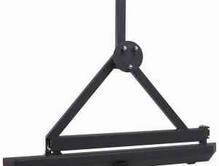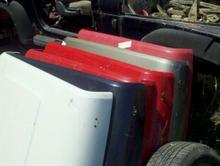Call Us: 810-650-3206
If you're looking for Jeep parts
Your at the right place
Call us for parts availability
New Off Road Bumpers
We carry several styles of offroad bumpers and swing out tire carriers.
New Repalcement Parts
Used Replacement Panels
Chris Fitzpatrick Offroad Products
We take pride in our wide selection of quality products. All of the products we offer are from trusted brands and can be picked up or shipped to you within 2-3 business days.
If you have any questions regarding our products or would like more information, please contact us:
810-650-3206 Chris
We carry new replacement panels such as tailgates, fenders, windshield frames, glass, and other parts.
We carry good used replacment panels in many colors. Panels such as hoods, fenders, tailgates, windshield frames, tubs, grills, and others.
Call with request.
Used Replacment Parts
We carry almost every used part that comes on a Jeep Wrangler. Such as frames, drive train, steering, interiors, electronics, rollbars, and everthing else.
Call with request.
Tires and Wheels
Wrangler Tops and Doors
We carry a Large selection of used and sometimes new tires and wheels.
Sizes from stock to large offroad.
Call with request.
We carry Wrangler hard, soft, half , and safari tops in many colors new and used. We also carry hard full, and half doors. As well as canvas doors
High quality and 100% customer satisfaction are our top priorities.
Double click here to add text.
The Jeep Wrangler is a compact four-wheel drive off-road and sport utility vehicle (SUV), manufactured by American automaker Chrysler, under its Jeep marque – and currently in its third generation. The Wrangler is a direct descendant of the World War II Willys military "Jeep" by way of the Willys civilian Jeeps (CJ models) of the mid-1940s through 1980s, later produced by Kaiser-Jeep and by American Motors (AMC).
Just like their predecessors, the Willys MB and the CJ Jeeps, Wranglers continue to use a separate body and frame, rigid live axles both front and rear, a fold-flat windshield, and can be driven without doors. The Wrangler debuted in 1986 as a revision of the Jeep CJ-7, was revised in 1996, and completely redesigned in 2006. In addition to the nameplate Wrangler, each model received a designation corresponding to its generation: YJ (1986–1995), TJ (1997–2006), LJ's (2003–2006 Unlimited models) and JK (2007–present). Military versions of the Wrangler have carried the J8 designation.
YJ models were manufactured between 1986 and 1992 at AMC Brampton Assembly Plant, and subsequently at the Toledo South Assembly Plant plant.[1] In 2006, Wrangler production was moved to Toledo Supplier Park.[2] The Wranglers were set apart from their predecessors by the angle of the grille. In all previous models, the grille was flat and even with the front fenders. The Wrangler was constructed with a grille which angled out toward the top, and then continued in a straight line from the midway point, toward the bottom. This decreased the hood length, while increasing the length of the fenders. In more recent models, this angle has been lowered more toward the bottom of the grille.
Yj 1987 to 1995
The Jeep YJ, sold as the Wrangler, replaced the much-loved but slower-selling Jeep CJ in 1986 and was built in Brampton, Ontario, Canada, until the plant closed on April 23, 1992. Production was then moved to Toledo, Ohio, using the same plant that produced the Willys Jeeps during World War 2. American Motors Corporation (AMC) had designed the new Jeep to be more comfortable on-road in an attempt to attract more daily drivers.[5] It was a new design with a wider track, slightly less ground clearance, and more comfort. The YJ still had leaf spring suspension similar to that of the CJ - however the springs were wider, and the YJs sported trackbars and swaybars for improved handling. Despite the new grille, the body is very similar to that of the CJ7, and it is interchangeable with some minor modifications. The YJ also was given a larger windshield over the CJ. The YJs are easily identifiable due to the rectangular headlights, disliked by some Jeep aficionados, and the fact that the wiper blades rest on the windshield giving this version a distinctive look. The blades rested on the windshield due to the now wider arc of the blades to clean the larger windshield. These two changes were later removed when the TJ changes came about in 1996. 632,231 YJs were built through model year 1995, although YJs were still produced into mid-1996, bringing the total production number to 685,071 units.
The YJ used a 2.5 L AMC 150 I4 or optional 4.2 L AMC 258 I6 until 1991. That year, a fuel-injected 180 hp (134 kW) 4.0 L AMC 242 variant replaced the 112 hp (84 kW) 4.2 L 258 CID straight-6. The NP207 transfer case was used only for 1987 and replaced by the NP231.
The roll cage was extended in 1992 to allow for rear shoulder belts, and anti-lock brakes were added as an option the next year. An automatic transmission option for 4-cylinder Wranglers came in 1994, along with a center high-mounted brake light.
In 1994, the slave cylinder on manual transmissions was moved outside of the transmission's bellhousing to allow for easier replacement, and in 1995 the Dana 30 larger U-joints were used [front axle U-joints (297x) and rear pinion U-joint (1330)]. For the 1992 model year, the YJ switched over to an electronic speedometer, outmoding the cable speedos on older YJs. 1995 was the only model year to have a fully galvanized frame and body.
There were no 1996 model year Jeep Wranglers.[6] YJs produced in early 1996 were sold as 1995 model years, but featured a few new parts not seen on any earlier YJ. This included the new TJ bumpstops on the hood (rubber boots vs the traditional U-bars), reinforced tailgate hinges, and some even had rear TJ bumpers. Some also got the newly tuned I6 that was designed to run quieter in preparation for the TJ.
Top options for YJ were the same as those offered on TJ. A Soft top with "half doors", featuring soft plastic zipper windows came standard (windows could be removed completely from these doors). Full-frame doors with conventional glass windows were optional on soft-top models. Hard tops with rear wiper and defroster were optional, but came standard with full-framed doors. The YJ featured large mirrors with manually adjustable arms on half-door models, while full-framed doors received smaller adjustable mirrors with fixed arms (which were mounted further away from the door corner, compared to the larger-style mirrors). Depending on year and interior color, Jeeps could be had with the top colors in black, white, tan and gray. Roll-bar padding normally matched top color, with the exception of white tops.
TJ 1997 to 2006
The YJ gave way to the TJ for the 1997 model year (note that there was no 1996 model year; the 1997 TJ was released in Spring 1996). This updated Wrangler featured a coil-spring suspension (based on that of the Jeep Grand Cherokee) for better ride and handling, and a return to the classic CJ's round headlamps. The engine is the same 4.0 L AMC 242 Straight-6 used in the Cherokee and Grand Cherokee. A 2.5 L AMC 150 Inline-4 motor was available on entry-level models until 2003 when the 2.4 L DOHC 4-cylinder engine previously used on the Chrysler PT Cruiser replaced it.
A right hand drive version of the TJ was available for export markets, and was also offered for sale to US rural route postal carriers. The version offered to US postal carriers was only available with an automatic transmission.
The fuel tank became standard at 19 U.S. gallons (72 L; 16 imp gal) capacity. There were some changes that occurred between the 2002 and 2003 years that made some parts difficult to directly swap back and forth, but also made it easy to identify certain years. From 1997 to 2002, the side door mirrors were black metal framed mirrors; and from 2003 to 2006 they were plastic molded mirrors. The fit of hard and soft tops is slightly different, and the fabric and colors available changed from 2002 to 2003. In 2003, the 3-speed automatic transmission was replaced with a 4-speed automatic with overdrive. It has the standard option of turning off overdrive with a dash switch if desired. The radio bezels went from a rectangle in 2002 to a rounded-edged rectangle in 2003, so swapping these also required the console to either be swapped out or modified. The sound bar inside was changed to sound pods. The interior seats also changed design from 2002 to 2003, going from a rounder model to one with a distinct separation between back and headrest areas.
The standard skid plate was also revised for 2003 to make room for the Rubicon's bigger NV241OR transfer case. The change from the 30/32RH to the 42RLE also gained an additional skid plate.
This version of the Wrangler is also notable for being the last production vehicle to use AMC-related parts. The AMC Straight-4 engine was retired after the 2002 model year, and both the AMC Straight-6 engine and the door handles (the latter of which first appeared on AMC vehicles in the late 1960s) were retired along with this generation in 2006. Like the YJ Wrangler, the TJ Wrangler used both the AMC passenger car door handles as well as the larger door handles off the AMC-built Jeep CJ for higher-end models.
LJ 2003 to 2006
In 2003, Jeep introduced the Wrangler Unlimited (unofficially dubbed "LJ") with a 10-inch (250 mm) longer wheelbase (LWB), a Dana 44 rear axle with a 3.73 gear ratio and the Command-Trac 231 transfer case. In 2004, Jeep released the Rubicon Unlimited, which has the wheelbase of the Unlimited and the off-road features of the Rubicon such as front and rear Dana 44 axles with the Rock-Trac four-wheel-drive system, diamond plate rocker guards, 245/75R16 Goodyear MT/R tires, a six-speed manual transmission and other comfort and convenience options not offered on other Wranglers. This model of the Jeep Wrangler has nearly double the towing capacity than its shorter wheelbase sibling, due to the increased wheelbase size.n 2003, Jeep introduced the Wrangler Unlimited (unofficially dubbed "LJ") with a 10-inch (250 mm) longer wheelbase (LWB), a Dana 44 rear axle with a 3.73 gear ratio and the Command-Trac 231 transfer case. In 2004, Jeep released the Rubicon Unlimited, which has the wheelbase of the Unlimited and the off-road features of the Rubicon such as front and rear Dana 44 axles with the Rock-Trac four-wheel-drive system, diamond plate rocker guards, 245/75R16 Goodyear MT/R tires, a six-speed manual transmission and other comfort and convenience options not offered on other Wranglers. This model of the Jeep Wrangler has nearly double the towing capacity than its shorter wheelbase sibling, due to the increased wheelbase size.







